
Uncontacted Amazon Tribes – are they truly ‘uncontacted’? Can they really exist in this modern world of advanced technology? If so, how many are left? Should we contact them, or do they not want to be contacted?
The indigenous tribes of the Amazon have inhabited the rainforest for thousands of years and a large percentage of these people continue to live in complete isolation from the outside world. They are entirely self-sufficient: they hunt and produce their own food, create their own shelter, and provide their own security. Their customs and culture are therefore entirely unique.
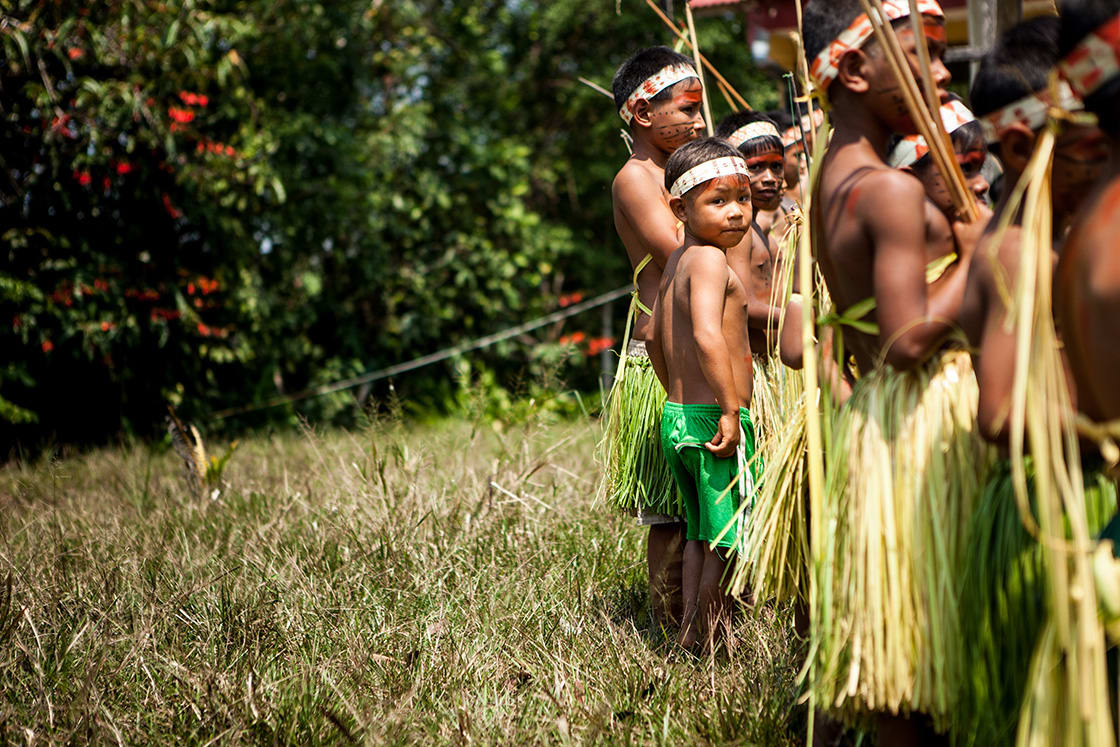
Children and Amazonia
It is estimated that some 300,000 indigenous people currently inhabit the Amazon rainforest, comprising of some 450 different tribes, who speak more than 150 languages. Amazonian tribes can hugely vary in size. The Yanomani tribe, for example, has some 22,000 members living in northern Brazil, yet in stark contrast, the Akuntsu tribe who occupies a small patch of forest in western Brazil has just 5 surviving members. There is even a single man in Brazil’s Rondônia state believed to be the sole surviving member of a tribe. Discovered in 1996 and commonly referred to as “the Last of His Tribe,” no one knows his name, that of his tribe, or the language he speaks. He is still thought to be alive, living a solitary life in a patch of forest, surrounded by cattle ranches.
Exactly how many of these tribes are uncontacted is unknown as their existence can only be ascertained from aerial surveys or talking to neighboring indigenous groups that are more open to communication with the Western world. However Survival International, an organization devoted to the protection of tribal peoples, estimates there to be 92 uncontacted tribes living in remote regions of the Amazon, with 15 remaining in Peru and 77 in Brazil. Some of the more famous uncontacted tribes include the Cacataibo, Isconahua, Matsigenka, Mashco-Piro, Mastanahua, Murunahua (or Chitonahua), Nanti, and Yora.
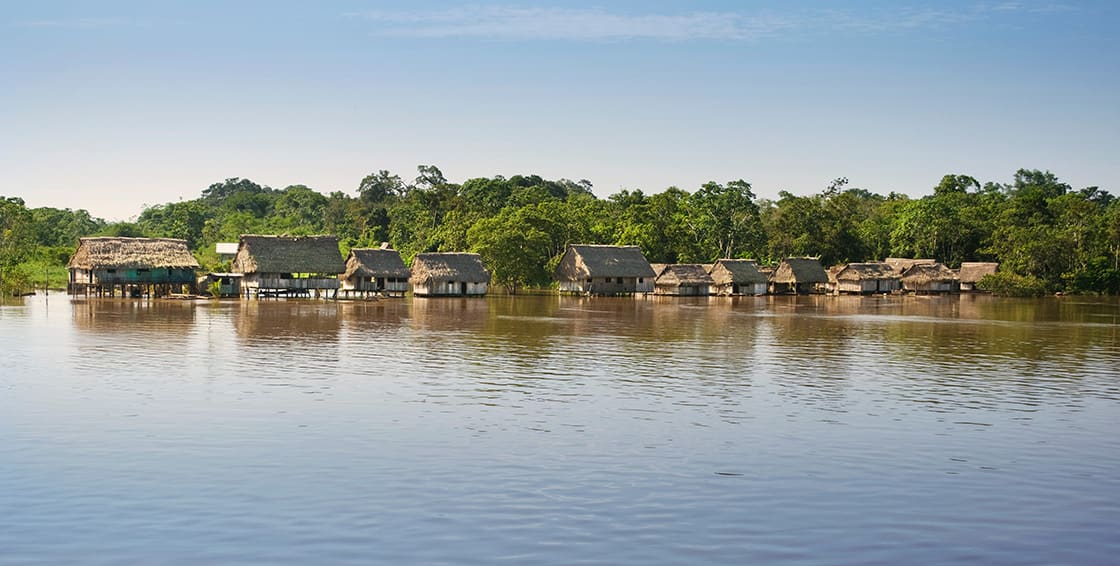
Typical Tribe Villages In Peru
These indigenous people tend to live in communal structures that are made out of bamboo and are then covered in palm leaves and straw. They grow their own fruits and vegetables like corn, beans, papaya and passion fruit and also hunt and fish. They use poison-tipped darts, blowguns, and bows and arrows to immobilize deer, tapir, and monkeys when hunting and sometimes use a plant-based poison to stun fish.
Men and women have distinct roles within their village. Women generally have the responsibility of cooking, household chores, crop growing, and taking care of the children, whilst the men do the hunting. Surprisingly hunting accounts for a relatively small amount of their total food intake. Instead, both men and women, and indeed the children, all take part in fishing.
There are also tribes that are nomadic such as the ‘uncontacted’ Awa tribe. They tend to live deep in the jungle, away from the rivers and these tribesmen have the ability to construct houses in hours. As expert hunter-gatherers, they never settle long enough to grow crops. As one might expect, so far away from ‘civilization’, they live without the need for electricity or power, living at one with the resources that nature provides.
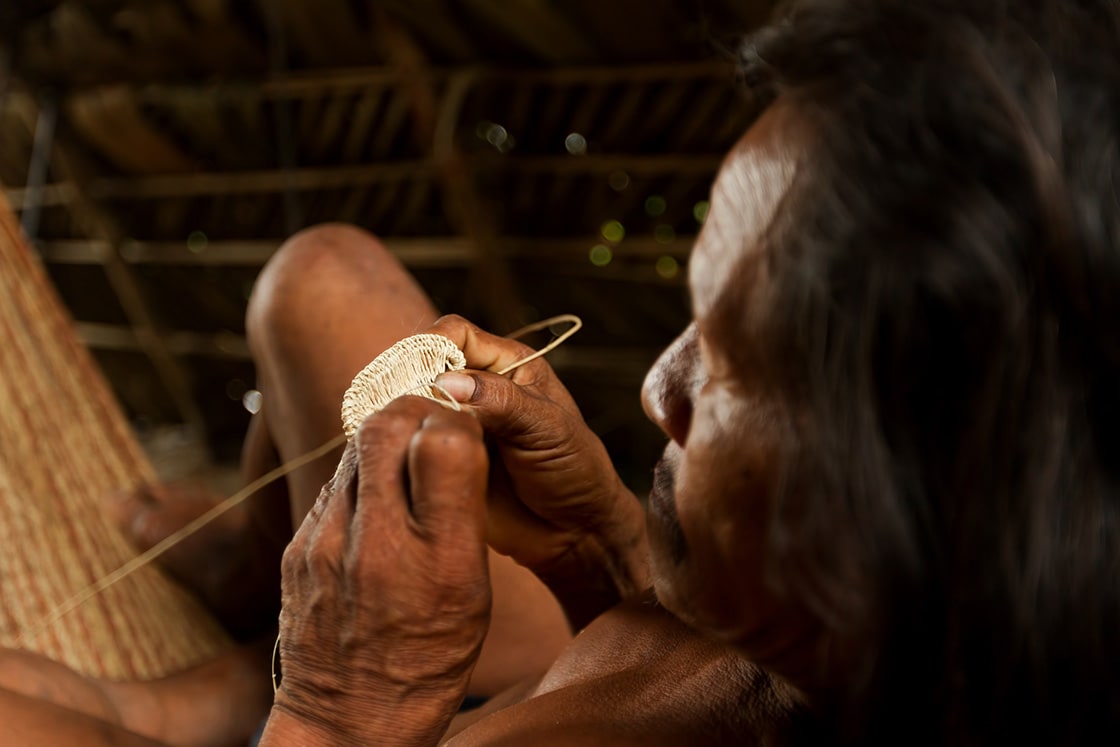
Yasuni Waorani Tribes Huaorani Amazonian
Most tribesmen and women alike wear very basic clothing, a straw skirt or simple loincloth. Those tribes, however, that have never had contact with the outside world will normally just live naked. Tribal face paint is another part of everyday culture and it normally has militaristic connotations, used as either camouflage or to scare an enemy. It can, however, also have religious undertones. Each color normally relates to a separate act: red is the color of war, white is the color of peace, black signifies battle preparation and yellow is the color of death.
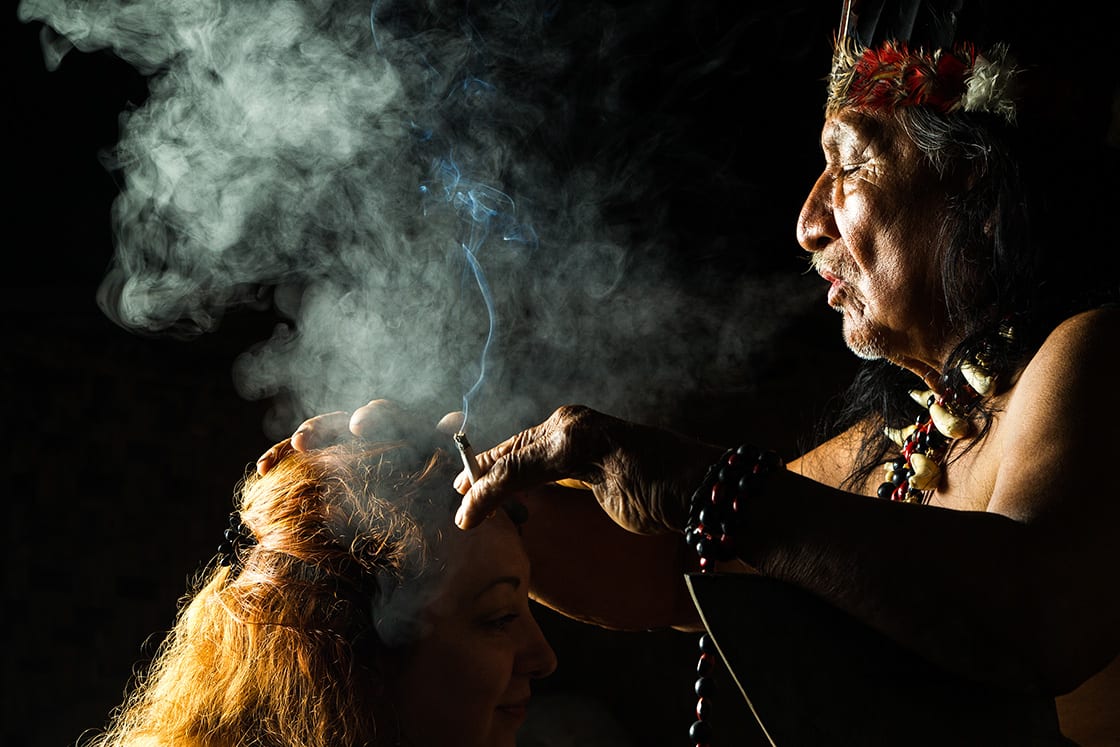
Shaman during Ayahuasca Ceremony
Rituals and spiritual ceremonies are also common amongst these Amazonian tribes. In the Satere Mawe tribe, to become a man, young boys must wear gloves full of bullet ants. Some who have been stung by such ants have compared the pain to being continually shot for 24 hours. Another common ritual amongst many Amazonian tribes is the belief in animism, that non-animalistic entities like plants and water possess a spiritual essence.
Often misleadingly described as “uncontacted,” most tribes have been in some kind of contact with the outside world at some point, some during the rubber boom era a century ago, a time when they were severely exploited, enslaved, and brutally massacred. It’s no wonder they retreated from their traditional homes near major rivers and ventured deeper into the jungle to live in isolation. For the past century, they have lived with an awareness – and fear – of the outside world and have made the conscious choice to become inaccessible.
In 2010 one such tribe from the Brazilian state of Acre was witnessed from the air by a plane that had been chartered to search for evidence of illegal logging. Fearful of a threat, and unsure as to what this machine was, the tribesmen fired arrows up into the sky in defense. From the evidence of first contact experiences, tribe members have been said to imitate animals as a way of expressing emotion, such as the sound of a jaguar for anger, and that of a wild pig when scared.

Aerial View Of Deforested Area Of The Amazon Rainforest
These indigenous tribesmen are at a growing risk of extinction from their native lands as their population is rapidly decreasing as a result of both legal and illegal practices. In the 1500s more than 7 million natives lived in the rainforest and this number decreased to 1 million by 1900. It now stands at 300,000.
Deforestation is a major threat to the Amazon and its peoples. It is estimated that currently 6,000 km² of Amazon rainforest is lost annually (that’s roughly 1.5 football pitches’ worth disappearing every minute!) and that if this continues at such a devastatingly high rate, it, and its inhabitants, will totally disappear within 50 years. There are many illegal logging operations taking place in these regions, hunting for the last remaining mahogany, or ‘red gold’ as it is called. Indeed recent reports indicate some of the tribes are relocating from Peru to Brazil for this very reason. “There has been a forced migration of autonomous groups in Peru, caused by mahogany exploration in the headwaters of the Jurua, Purus, and Envira,” Jose Carlos Meirelles, head of the FUNAI (the Brazilian government’s Indian Affairs Department) said.
Similar problems can be seen with oil development, which is furthermore destroying sections of the rainforest. For example, the Peruvian government has leased up to 70% of the Amazon to oil companies, who are continuing to explore previously uncharted territory deep within the jungle, which has made these encounters inevitable.
Drug trafficking is another concern that is driving the natives out of isolation. Instances occur where previously uncontacted tribes have emerged to the outside world seeking help after suspected drug lords and illegal loggers and miners have wounded and killed their people, as well as having occupied their land.
It is not just the immediate and violent threat of armed conflict that tribes face. Contact with the outside world can also have dangerous and disastrous delayed consequences. Frequently, the tribesmen will contract mumps, measles, and influenza, diseases to which their immune systems are not accustomed to and it is not unusual that up to 50% of a tribe’s population might be killed within a year or two of contact. This is particularly true for the more nomadic Indians like the Murunahua, with encounters becoming more and more frequent.
For decades, the governments of Amazon nations showed little interest in protecting these groups, often viewing them as unwanted remnants of backwardness. They often tried to force them into ‘mainstream’ society or relocate those who stood in the way of profitable commercial exploitation of the rainforest, thereby eliminating their cultural diversity and freeing up their lands. Worse still, corrupt officials within Brazil’s Indian Protection Service (SPI), often tortured, murdered, and even exterminated whole tribes in order to steal their land. In Peru, at one stage, the Peruvian government denied that uncontacted people even exist.
However, thanks to increased global awareness – explicitly the 1967 Figueiredo report (a shocking 7,000 pages long exposé on criminal actions against the indigenous population of Brazil) and subsequent 1969 Sunday Times article ‘Genocide’ – things are changing.
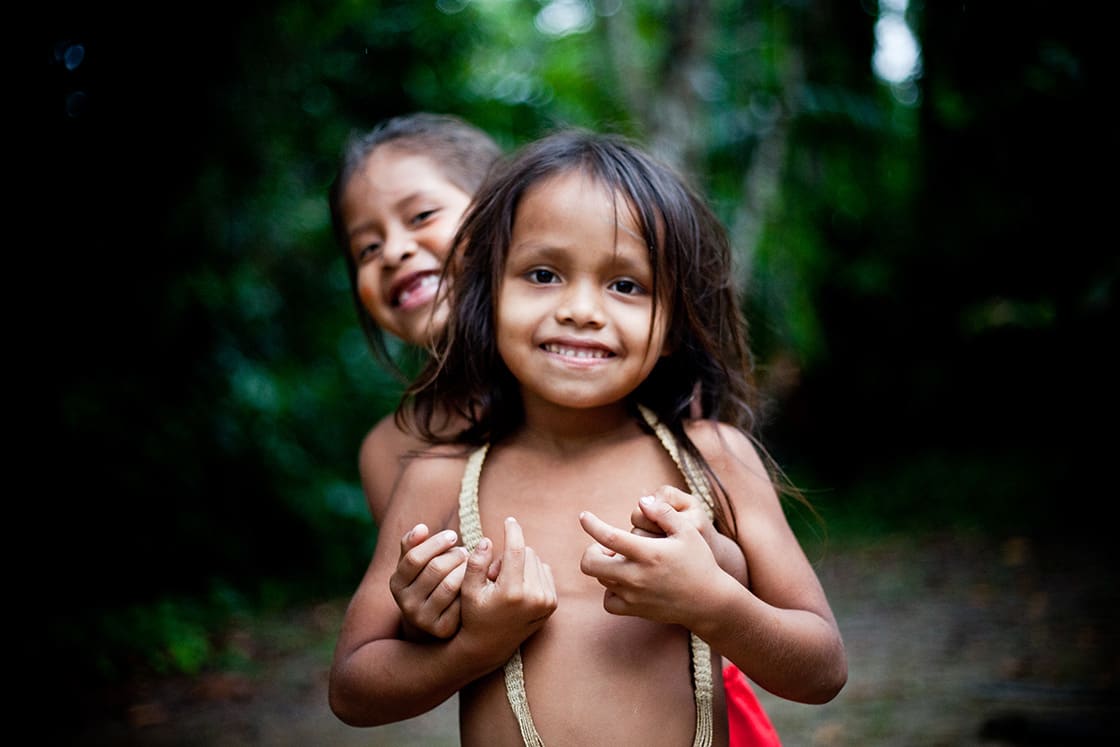
Girls Of Yagua Community
As a result of the above publications, in 1967 Brazil set up FUNAI (Fundação Nacional do Índio), Brazil’s National Indian Foundation, the only government department in the world dedicated to the protection of indigenous peoples, and in 1969 Survival International, the global movement for tribal peoples’ rights, was founded.
As part of its remit, Brazil’s FUNAI created a protected area of rainforest the size of Maine, the Javari Valley Indigenous Land, sealing it off to outsiders in perpetuity. Other Amazon nations, too, have taken measures to protect their indigenous peoples. In Manú National Park, Peru, which has some of the greatest biodiversity of any nature reserve in the world, permanent human habitation has been restricted to several tribes. Colombia has turned nearly half its Amazon region into protected areas, with 14.8 million acres of national parks, where all development is prohibited, and 66.7 million acres of private reserves owned by indigenous peoples. In 2011 the Colombian President also signed legislation that guaranteed “the rights of uncontacted indigenous peoples…to remain in that condition and live freely according to their cultures on their ancestral lands.”
However, these measures, although progressive, are seen by many to be insufficient. Despite governmental promises, the dark shadow of the rubber era atrocities still lingers. Last year, timber companies working illegally inside Manú National Park drove a group of isolated Mashco-Piro Indians from their forest sanctuary, and more recently four Ashaninka natives, included renowned leader Edwin Chota Valera, was assassinated for speaking up against illegal logging on their traditional lands.
Until land rights for the indigenous people of the Amazon rainforest are granted, governments stop allowing major oil and gas operations to operate on their lands, and tougher sentences are enforced for those involved in illicit mining and deforestation, mankind may well exist in one of its most primitive and purest forms in the Amazon … but not for long.
Travelers heading to the Amazon on vacation can meet and interact with indigenous Amazon tribes in person and learn about their traditional way of life aboard Amazon river cruises or when staying at select jungle lodges with Rainforest Cruises.
While Rainforest Cruises aim to provide accurate and up-to-date information, we make no representations as to the accuracy or completeness of any information herein or found by following any link on this site. Rainforest Cruises cannot and will not accept responsibility for any omissions or inaccuracies, or for any consequences arising therefrom, including any losses, injuries, or damages resulting from the display or use of this information.




